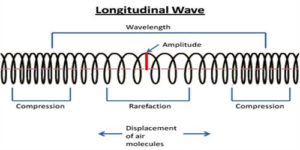Longitudinal Waves – Definition, Equation, Characteristics
A mechanical type of wave, which observes displacement in the same direction as the magnitude of the wave is referred to as Longitudinal Waves. There are multiple types of longitudinal waves, for example, Ultrasonic waves, Sound Waves, Seismic P Waves, etc. And this topic plays an important role in explaining how various important quantities such as displacement, amplitude, frequency, etc, change along or vary with the Longitudinal waves, which we are going to explain in much more detail below.

From the above diagram, you can understand the different types of quantities present in the Longitudinal Wave. Moreover, the distance between the two compressions and rarefaction in the diagram can be found by using wavelength. Based on Whether the two waves coincide with each other or not, there are further divided into two types, such as constructive interference and distractive interference.
Constructive Interference
When both compressions and rarefaction coincide with each other on the longitudinal wave, then it is called constructive interference.
Destructive Interference
As you can guess, in this form of a longitudinal wave, the compression region, and the rarefaction region do not coincide with each other like constructive interference. Then it is referred to as destructive interference.
Difference Between Longitudinal Waves and Transversal Waves
Now that we have talked about the Longitudinal Waves. Let us discuss how both parts of longitudinal waves and transversal waves differ from each other. These differences are,
| Parameters | Longitudinal Waves | Transversal Waves |
| Definition | A wave moves in the direction of its displacement. | A wave that moves perpendicular to its displacement. |
| Dimension | One Dimensional Wave | Two-Dimensional Wave |
| Medium | It can be observed in any type of medium, like Air, Gas, and Solid. | Whereas Transverse waves can be found only in Gas and Liquid Medium. |
| Constituents | It consists of compressions and refractions. | It consists of troughs and crests. |
| Examples | Sound Wave, and Ultrasonic Waves | Earthquake S Wave |
Formula of Longitudinal Waves
The Longitudinal wave is mathematically expressed as,
\(y(x,t)= y_{0}cos[ \omega (t- \frac{x}{c} )]\)
Where y = displacement of a point in Longitudinal wave.
X = distance traveled by the point
C = speed of a wave
\(\omega \)= angular frequency of the wave
T = time elapsed
\( y_{0} \)= amplitude of oscillations
\(\frac{x}{c} \) = Time
Characteristics of Longitudinal Waves
There are many characteristics involved in Longitudinal Waves, which we will explain briefly here in this section.
- Rarefaction – In a longitudinal wave, when the particles are furthest apart from each other, then they are called refraction.
- Amplitude – The distance between the equilibrium position in the medium, and the rarefaction or compression is called amplitude.
- Frequency – The number of wavelengths per second in the Longitudinal wave is referred to as frequency.
- Compression – In a longitudinal wave, when the particles are much closer to each other than it is referred to as compression.
- Wavelength – The distance between two consecutive points involving either compression or rarefactions is stated as wavelength.
- Period – The time taken by the wave to cover one wavelength is described as a period.
Conclusion
The above article provided a comprehensive description of Longitudinal Waves, Equations, Definitions as well as Characteristics. So, if you are struggling with any other topics or chapters in this particular subject, then it would be a better idea for you to join any good online coaching class. One such customized online interactive class is offered by the Tutoroot platform, which comes with various benefits including cost-effective prices, expert staff guidance, access to the best subject-related materials, and a lot more.
